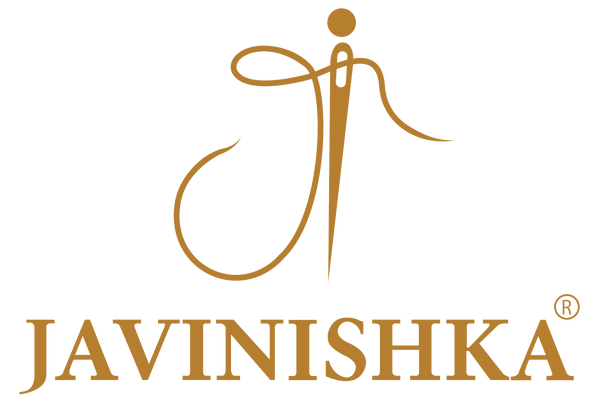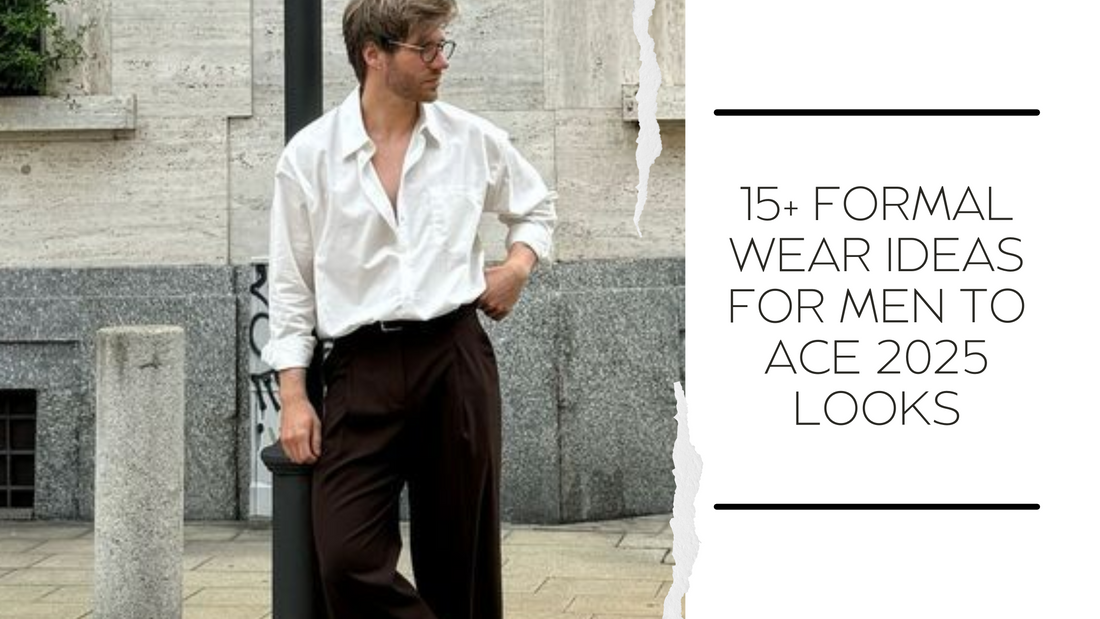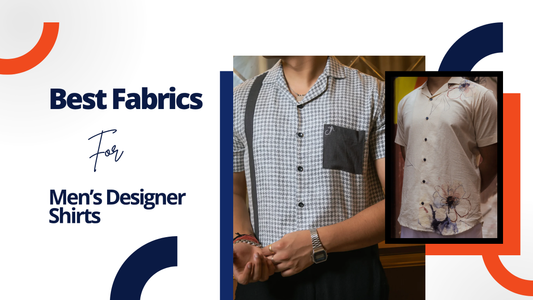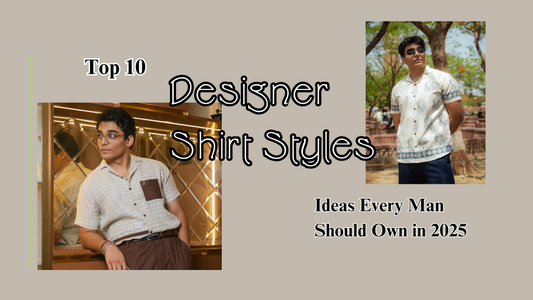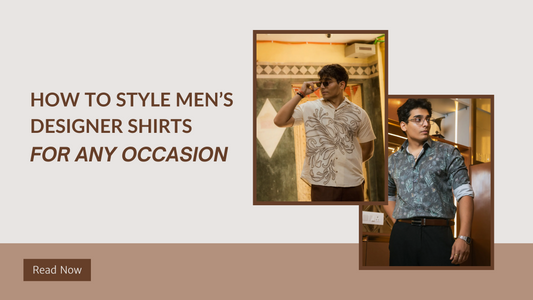The line between formality and flexibility in men’s fashion has thinned in 2025. While dressing down dominates pop culture and workspaces have adopted hybrid wardrobes, the relevance of formal wear ideas for men has only grown sharper.
Today, formals no longer mean stiff suits and predictable black-and-white codes. Instead, it's a culmination of creativity where confidence, body fit, cultural context, and occasion-oriented styling drive the look.
Be it preparing for a high-stakes meeting, a destination wedding, or a networking event, your formal wardrobe should support function with style. Read this blog to explore 15+ formal attire ideas for men that suit modern times, diverse occasions, and evolving silhouettes.
Formal Outfit Ideas for Office Meetings
Despite the rise of business casual, office environments in 2025 still demand polished looks for client-facing roles, boardroom presentations, or Monday reviews. Formal outfits signal reliability, authority, and attention to detail.
Best Suits for Corporate Settings
Opt for single-breasted suits in classic colors like navy, mid-grey, or graphite. These shades transition seamlessly from meeting rooms to off-site visits. Stick to wrinkle-resistant wool or a blended suiting fabric with elastane for ease during long hours.
Shirt Pairing Suggestions
Always pair darker suits with neutral-tone dress shirts. White remains the safest choice, but powder blue or micro-checked patterns offer understated style. Among the most reliable options for daily rotation are breathable and crisp cotton Men Shirts, which retain structure throughout the day.
Ideal Footwear and Accessories
Stick to oxford shoes or leather derbies in black or dark brown. Avoid slip-ons or loafers unless your workplace supports a creative formal dress code. For accessories, wear minimalist cufflinks, a leather-strapped watch, and a textured silk tie that complements your shirt but avoids overpowering it.
Final Styling Tip
Ensure your trousers have a slight break. Office formal pants should graze the shoe laces without excessive pooling. Finish with a belt that matches your shoes, and avoid bold contrast socks unless your workplace embraces sartorial flair.
In warmer regions, linen shirts in classic tones like white, sky blue, or pale pink bring breathable charm to your daily office ensemble without compromising on decorum.
Formal Looks for Weddings and Receptions
Weddings in 2025 have embraced flair. Grooms, guests, and groomsmen are steering away from predictable styles and exploring tailored creativity.
Dressing According to the Wedding Type
The nature of the wedding dictates how formal you need to be. For black-tie events, a classic tuxedo with satin lapels, pleated front shirt, and bow tie is essential. For less formal receptions or day weddings, a well-tailored two-piece suit in earthy or pastel tones works best.
Choosing the Right Suit Fabric and Color
Day weddings call for lightweight wool or linen blend suits in colors like taupe, sage, or light blue. For evening receptions, opt for deeper tones like charcoal, burgundy, or midnight blue. Seasonal adjustments also matter. For winter weddings, brushed wool or velvet blazers can offer an elevated look without compromising warmth.
Shirt Pairing and Statement Collars
For evening occasions, pair your suit with Designer Shirts that feature a structured spread collar or slight sheen. Crisp whites are timeless, but ivory or soft blush tones can complement both western and traditional Indian receptions. Use cuffed sleeves for added elegance when you’re not wearing a blazer throughout.
Footwear and Detailing Essentials
Choose patent leather lace-ups for evening formality or suede loafers for outdoor day receptions. A soft pocket square folded into a puff, a lapel pin that ties in your boutonniere, and an elegant watch without complications can complete the look. Avoid sneakers or open footwear at all costs.
Grooming and Finish
A well-ironed shirt and lint-free suit are non-negotiables. Trimmed beards and styled hair will enhance your overall formality. Carry a subtle fragrance that matches the occasion’s mood and crowd.
Classic Suit Styles Every Man Should Own
When it comes to men’s formalwear, some suit styles never go out of rotation. A well-curated wardrobe must include silhouettes that offer versatility, visual presence, and structure.
Two-Piece Suit
The two-piece suit is the everyday essential. Ideal for office meetings, formal luncheons, or post-work events, it delivers structure without excess. Stick to classic tones like navy, charcoal, or stone grey. Choose mid-weight wool with a light lining and minimal shoulder padding. Finish the look with designer shirts and brown derbies for balance.
Double-Breasted Suit
More tailored and expressive, the double-breasted suit suits taller or athletic body types. Its overlapping front and strong lapels build natural shape and presence. A deep forest green or slate blue in stretch wool creates dimension without overpowering the look. Ideal for formal dinners, evening functions, and upscale events.
Three-Piece Suit
This includes a matching waistcoat, which instantly sharpens your profile and elongates the torso. Choose fabrics with subtle texture — birdseye or nailhead weaves are great options. Wear it to weddings, gala events, or executive boardrooms. Keep the vest snug, and leave the bottom button undone for a cleaner silhouette.
Patterned or Textured Suit
When solid colors feel repetitive, a pinstripe or houndstooth suit adds flair. These are best worn at fashion-forward gatherings or semi-formal day events. Keep accessories minimal. The pattern should stand on its own, paired with plain shirts and neutral-toned shoes.
If your style leans edgy, pair structured pants with crochet shirts under overshirts to add textural dimension, a trend that's seeing traction in 2025.
Perfecting the Formal Pant Look
Trousers often play second fiddle to jackets, but in reality, they anchor the entire structure of a formal outfit. Ill-fitted or outdated pants can undercut even the most refined suiting. A well-chosen pair of trousers adds proportion, balance, and polish to your overall appearance. Here's how to perfect the pant game in your formal wardrobe.
Tailoring and Silhouette
Opt for flat-front trousers or single-pleated styles, depending on your body type. Flat-front offers a streamlined appearance suitable for lean to average builds. Single pleats add slight volume and are more forgiving for athletic or broader frames. Tapered legs with a clean, narrow ankle make the silhouette more modern and versatile across events.
Length and Break
Gone are the days of pooled hems. Ankle-length trousers with minimal or no break sit elegantly above the shoe line and create a crisp, clean structure. For office wear, a slight break works with oxfords. For post-work socials, try cropped lengths paired with loafers or sleek monk straps.
Rise and Comfort
Mid-rise trousers are ideal for tucking in formal shirts without causing fabric bunching. They help define the waist without making the torso appear shortened or the legs disproportionately long. Avoid ultra-low-rise cuts, which distort posture and throw off the proportions of a well-fitted blazer.
Fabric and Pairing Strategy
Wool-poly blends or stretch gabardine offer wrinkle resistance, making them ideal for long workdays or travel. For less rigid occasions like after-office gatherings or work parties, consider pairing neutral trousers with Printed Shirts to inject personality without losing the formality.
Blazers vs. Suits – When to Wear What
Understanding the difference between blazers and suits is fundamental to dressing appropriately for various formal and semi-formal settings. While both are structured, their context, construction, and pairing potential make them ideal for different occasions.
Suits: The Go-To for Formal Events and Business Protocols
Suits consist of a matching jacket and trousers made from the same fabric, which creates a cohesive and uniform look. They are ideal for boardroom meetings, corporate presentations, formal weddings, and diplomatic events. Stick to classic tones like navy, charcoal, or deep grey in performance wool blends for all-season wear.
Pair with a crisp white shirt, leather oxfords, and silk tie for a complete, regulation-ready ensemble. Avoid mixing suit jackets with non-matching trousers as it compromises the formal balance of the outfit.
Blazers: The Flexible Choice for Smart-Casual or Day Events
Blazers are single garments that can be mixed and matched with tailored trousers, chinos, or even dark denim for more relaxed settings. They come in textured fabrics like hopsack, twill, and lightweight wool, allowing for seasonal versatility. A neutral blazer paired with contrasting pants works well for daytime office events, after-hours networking, or celebratory lunches.
You can layer a fine gauge knit instead of a shirt for contemporary styling. For casual Fridays or creative industries, pair structured blazers with cargo shirts or other utilitarian-inspired shirts to subtly dial down the formality while maintaining definition.
What is Formal Wear vs Semi Formal Wear
Definition of Formal Wear
Formal wear refers to the highest level of dress codes, often including tuxedos or structured suits in dark tones, paired with a crisp shirt and dress shoes. The look remains consistent and is worn for black-tie events, ceremonial functions, or boardroom meetings requiring sartorial precision.
Definition of Semi Formal Wear
Semi-formal attire maintains a sharp silhouette but introduces lighter fabrics, varied colors, and optional ties. It allows for pairing structured blazers with tailored trousers or even subtle patterns. Perfect for day events, work parties, or dressy dinners, it gives flexibility without compromising neatness.
Key Fabric Choices
Formal wear leans on wool, high-twist yarns, and clean weaves for a pristine finish. Semi-formal styles explore wool blends, textured cotton, or structured linen. Tie Dye Shirts or relaxed shirts in neutral prints can occasionally work under semi-formal blazers for modern touchpoints.
Shirt and Footwear Combinations
Formal shirts are solid, minimally styled with French cuffs. Leather Oxford shoes or Derbies complete the outfit. Semi-formal styles can accommodate Cuban collar shirts, suede loafers, or slip-ons, depending on the occasion and trousers chosen.
When to Wear Which
Use formal wear for black-tie weddings, galas, and corporate summits. Semi-formal is ideal for engagement parties, upscale social events, and post-office dinners. Understanding the tone of the event helps in making the right choice.
Styling Formal Wear for Different Body Types
Every physique demands different tailoring rules. Your formal outfit should balance proportions, not fight them. Here's how to play to your strengths and make smart choices that elevate your structure.
Athletic Body Type
Men with defined shoulders and a narrow waist benefit from suiting that emphasizes symmetry. Structured blazers with light padding balance upper and lower halves, while flat-front trousers in performance fabrics maintain a sleek silhouette. Lightweight Modal Shirts complement formal pieces by softening the muscular form without clinging too tightly, making transitions from desk to dinner effortless.
Slim Body Type
A slim build requires garments that add volume without overwhelming. Heavier fabrics like brushed wool, herringbone, or flannel add natural shape. Jackets with moderate shoulder structure and wider lapels broaden the chest, while pleated trousers create better lower-body proportion.
Broad Upper Body
For broader frames, clean lines and vertical focus help streamline the torso. Single-breasted jackets with minimal padding avoid added bulk, while mid-rise trousers balance the frame’s base. Shirt choices should lean toward fluid fabrics that fall straight, such as cotton-satin blends or natural drapes.
Shorter Height
Men with shorter height appear taller with uninterrupted lines and well-fitted proportions. Cropped blazers and ankle-length trousers offer elevation. Shirts should be tucked neatly into mid-rise pants to create a longer leg line. Minimal break in trousers, narrow lapels, and a monochrome base layer all contribute to visual elongation.
Taller Frame
Longer torsos and legs are best framed by medium-length jackets with strong waist definition. Layered separates help break visual length. Wider trouser hems, cuffed pants, and horizontal accents like subtle checks add grounding.
Accessorizing Right — Ties, Pocket Squares, Cufflinks & Footwear
Accessories are not afterthoughts. They frame your formalwear choices, accentuate personality, and sharpen the overall visual story.
Ties: Framing the Upper Half
A well-chosen tie enhances vertical structure and adds visual weight to a shirt’s neckline. Stick to silk or knitted textures for boardroom confidence. Neutral palettes like navy, charcoal, and burgundy pair effortlessly with most suits, while slim-width designs suit leaner builds. Ties also help introduce character subtly, especially when balanced against a muted jacket.
Pocket Squares: Elevating Details
Pocket squares lend dimension without shouting for attention. Choose linen or silk blends depending on the texture contrast with the blazer. For example, soft pastels or microprints sit well against structured navy jackets. Fold types—from presidential to puff—should be selected based on formality level, not trend. A pocket square never needs to match the tie directly, but harmony is key.
Cufflinks: Functional Embellishments
Cufflinks are both utilitarian and expressive. Opt for metal tones that align with your watch or belt buckle. Enamelled or engraved pieces subtly introduce personality without compromising the outfit's formality. French-cuff shirts are essential when using cufflinks, especially during evening affairs or weddings. Understated designs convey refinement better than novelty shapes.
Footwear: Grounding Your Ensemble
Oxfords remain the most traditional choice for black-tie events, while Derbies offer versatility across business and formal settings. Monk straps and Chelsea boots modernize the look when worn with cropped trousers. Stick to polished leather in tones of black, oxblood, or walnut brown. Shoes should align with belt tone and watch strap for cohesion.
Mistakes to Avoid in men's formal outfit dressing
Even the most luxurious outfit can unravel with one careless styling move. In formal menswear, elegance lies in the details, get those wrong, and the entire look feels off-balance. Below are key errors that consistently derail men’s formal appearances, and more importantly, how to sidestep them with precision.
1. Prioritizing Style Over Fit
A designer suit loses its value if the shoulders droop or the pants puddle at the shoes. Tailored silhouettes that follow your body's lines, not fight them, are the true foundation of refined dressing. Prioritize personal proportions over trends.
2. Turning Accessories Into a Distraction
When the tie, lapel pin, cufflinks, and pocket square all fight for attention, the outfit starts to feel like a costume. Choose one or two refined accents that enhance rather than overpower your tailoring. Clean accents speak louder than cluttered layers.
3. Misjudging Fabric Personality
Every fabric carries its own language, and reading the room begins with knowing what speaks too loudly. While Ikat Shirts offer an artisanal edge and cultural richness, they often clash with the clean, structured mood of formal wear. Keep such expressive pieces for festive settings or heritage-inspired events.
4. Forgetting Texture and Color Coordination
Texture should complement, not compete. A shiny belt against matte shoes creates unnecessary visual noise. Similarly, if your ensemble leans into neutral tones, tossing in a Hand Printed shirt can break cohesion. Keep the palette unified and fabrics consistent for better flow.
5. Neglecting the Smallest Alignments
Your belt buckle, cufflink metal, and watch finish, these need to align. Polished silver with worn-out bronze breaks continuity. Shoe and belt colors, collar stays, and even sock length should be in sync to reflect sharp attention to detail.
FAQ's
Q1. How to style formal pants for men?
Choose mid-rise wool or poly-viscose trousers with a clean break. Anchor them with monk straps and poplin shirts. Add minimal waist suppression to keep proportions sleek. Avoid tapered silhouettes for boardroom setups; opt for a straight-leg design with pleat depth.
Q2. What to wear to look formal?
Stick to suiting with engineered shoulders, a structured lapel, and natural drape. Shirts should feature a spread collar or pin collar for shape. Complete the outfit with oxfords or derbies in polished leather to maintain sartorial gravity in formal settings.
Q3. What is the most formal thing a man can wear?
The white tie ensemble leads in formality. Think hand-stitched evening tailcoat, stiff-front Marcella shirt, high-waist formal trousers, and patent leather pumps. This code is rare and strictly reserved for diplomatic galas or royal-affiliated occasions.
Q4. What are some stylish formal wear ideas for men for office and events?
Deploy neutral-toned blazers with subtle checkered textures and flat-front trousers. Introduce minimal detailing via metal cufflinks or textured ties. For post-office transitions, swap your shirt for a knitted polo and layer with a deconstructed jacket for flexibility.
Q5. Which shirt types are best suited for a formal look?
Stick to classic dress shirts with fine plackets, fused collars, and structured cuffs. Modal shirts and mercerized cottons offer luxury finishes. Avoid Cuban collar shirts unless it’s a semi-formal tropical venue or fashion-forward event.
Q6. Can Korean fit linen pants be worn for formal occasions?
Yes, when styled intentionally. Pair Korean-fit linen pants with tailored blazers, handstitched belts, and solid-toned shirts. Prioritize neutral shades and a pressed finish. Avoid boxy uppers or loud prints to keep the silhouette elegant.
Q7. What color combinations work best for formal shirts and men’s pants?
Slate grey trousers work with muted lilac, powder blue, or ivory shirts. For navy bottoms, choose tonal blues or off-whites. Stick to analog color theory when pairing. Reserve earth-tone combos for autumn or business-casual setups.
Q8. How do I accessorize a formal outfit for a polished appearance?
Use calfskin leather footwear, brushed steel or matte cufflinks, and a hand-folded pocket square with low-contrast hues. Choose ties in grenadine or repp silk. Limit accessories to three visible pieces to maintain formality without visual clutter.
